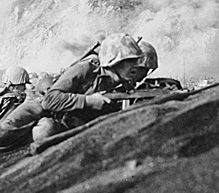UNIFORMS
Many details of Marine uniforms reflect the proud legacy of warriors who have served our nation for more than two centuries. This virtual tour starts with the Marine Corps Combat Utility Uniform, or cammies, which Marines wear as their standard uniform in garrison, during training and while deployed overseas. This portion also shows much of the personal protective equipment, weaponry and other gear that a Marine may use. Also included in the tour is the Dress Blue uniform, which is worn in more formal situations.
UNIFORMS
Many details of Marine uniforms reflect the proud legacy of warriors who have served our nation for more than two centuries. This virtual tour starts with the Marine Corps Combat Utility Uniform, or cammies, which Marines wear as their standard uniform in garrison, during training and while deployed overseas. This portion also shows much of the personal protective equipment, weaponry and other gear that a Marine may use. Also included in the tour is the Dress Blue uniform, which is worn in more formal situations.
MARINE CORPS RANKS
Marine Corps ranks represent more than the chain of command. Marines constantly strive to achieve, and every success demonstrates commitment to the mission and to fellow Marines. Each successive Marine Corps rank confirms that the men and women who wear it have earned positions of greater leadership and responsibility.
ENLISTED RANKS
Starting with the first day of recruit training, recruits are assigned responsibilities designed to develop leadership skills. As Marines begin to earn promotions in the enlisted rank structure, both the demands and their responsibilities increase. These are the grades found in the Marine Corps' enlisted rank structure.
OFFICER RANKS
Enlisted Marines look to their Marine Officers for guidance and leadership. These officers are distinguished by their "commission," a formal document from the President of the United States, conferring the rank and authority of a Marine Corps Officer. These are the grades found in the Marine Officer rank structure.


THE SWORD
The oldest weapons still in service in the United States Armed Forces belong to Marines. Today, the swords Marines carry represent the Marine Corps' rich heritage as America's original defenders. Officers carry the Mameluke Sword, which was originally given to Lieutenant Presley O'Bannon in 1805 by a Mameluke chieftain in North Africa. Lt O'Bannon and his Marines marched across 600 miles of North African desert to rid the "shores of Tripoli" of pirates and rescue the kidnapped crew of the USS Philadelphia. By 1825, all Marine Officers carried the Mameluke sword in recognition of this historic battle—the Marine Corps' first on foreign soil.
Adopted in 1859, the NCO Sword is carried by Marine Noncommissioned Officers (NCOs) and Staff Noncommissioned Officers (SNCOs). Used for ceremonial purposes, the M1859 NCO Sword was bestowed to NCOs and SNCOs by the 6th Commandant, Colonel John Harris, in recognition of their leadership in combat.
THE SWORD
The oldest weapons still in service in the United States Armed Forces belong to Marines. Today, the swords Marines carry represent the Marine Corps' rich heritage as America's original defenders. Officers carry the Mameluke Sword, which was originally given to Lieutenant Presley O'Bannon in 1805 by a Mameluke chieftain in North Africa. Lt O'Bannon and his Marines marched across 600 miles of North African desert to rid the "shores of Tripoli" of pirates and rescue the kidnapped crew of the USS Philadelphia. By 1825, all Marine Officers carried the Mameluke sword in recognition of this historic battle—the Marine Corps' first on foreign soil.
Adopted in 1859, the NCO Sword is carried by Marine Noncommissioned Officers (NCOs) and Staff Noncommissioned Officers (SNCOs). Used for ceremonial purposes, the M1859 NCO Sword was bestowed to NCOs and SNCOs by the 6th Commandant, Colonel John Harris, in recognition of their leadership in combat.

MARINE CORPS FLAG
Marines have carried several different flags since the American Revolution, but today's scarlet standard has been flown since January 1939. The Eagle, Globe and Anchor emblem is rendered in gray and gold over the scarlet background. The ribbon flowing from the eagle's beak bears the motto, "Semper Fidelis," and the words "United States Marine Corps" are found on the scroll below. Scarlet and gold were established as the official colors of the Corps as early as 1925, and the Eagle, Globe and Anchor emblem has appeared as part of Marine Corps iconography since 1868. In addition to being flown at ceremonies and installations and presented by the All-Marine Color Guard, the Marine Corps flag hangs in the offices of the President of the United States, the Secretary of Defense, the Secretary of the Navy, and the Chairman and Vice Chairman of the Joint Chiefs of Staff.








































